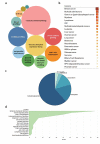Trial watch: chemotherapy-induced immunogenic cell death in immuno-oncology
- PMID: 32002302
- PMCID: PMC6959434
- DOI: 10.1080/2162402X.2019.1703449
Trial watch: chemotherapy-induced immunogenic cell death in immuno-oncology
Abstract
The term 'immunogenic cell death' (ICD) denotes an immunologically unique type of regulated cell death that enables, rather than suppresses, T cell-driven immune responses that are specific for antigens derived from the dying cells. The ability of ICD to elicit adaptive immunity heavily relies on the immunogenicity of dying cells, implying that such cells must encode and present antigens not covered by central tolerance (antigenicity), and deliver immunostimulatory molecules such as damage-associated molecular patterns and cytokines (adjuvanticity). Moreover, the host immune system must be equipped to detect the antigenicity and adjuvanticity of dying cells. As cancer (but not normal) cells express several antigens not covered by central tolerance, they can be driven into ICD by some therapeutic agents, including (but not limited to) chemotherapeutics of the anthracycline family, oxaliplatin and bortezomib, as well as radiation therapy. In this Trial Watch, we describe current trends in the preclinical and clinical development of ICD-eliciting chemotherapy as partner for immunotherapy, with a focus on trials assessing efficacy in the context of immunomonitoring.
Keywords: Antigen-presenting cell; CAR T cells; autophagy; chemokines; cytokines; cytotoxic T lymphocyte; dendritic cell; endoplasmic reticulum stress; immune checkpoint blocker; type I interferon.
© 2020 The Author(s). Published with license by Taylor & Francis Group, LLC.
Figures

References
Publication types
MeSH terms
Substances
LinkOut - more resources
Full Text Sources
Other Literature Sources
Medical
Research Materials
